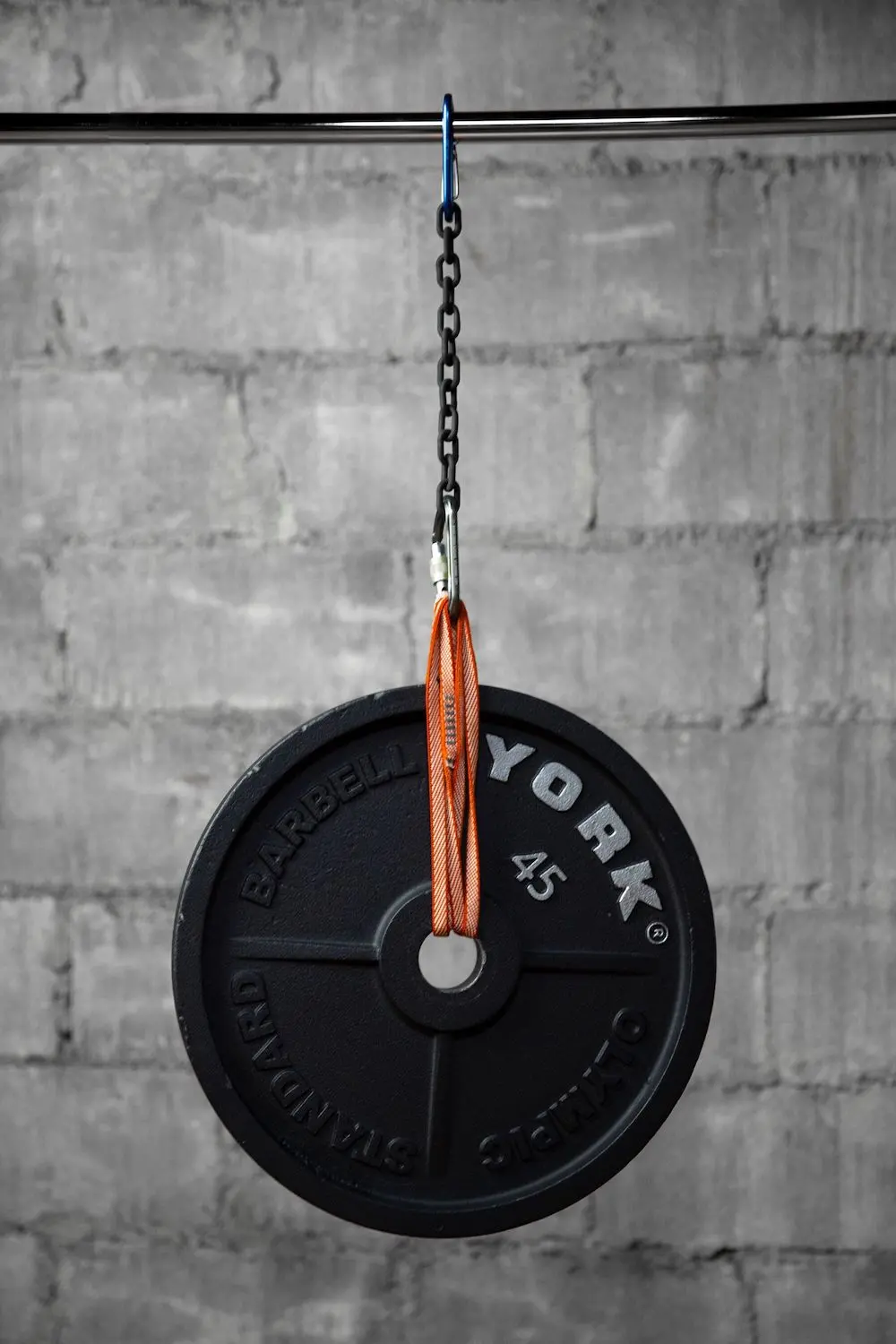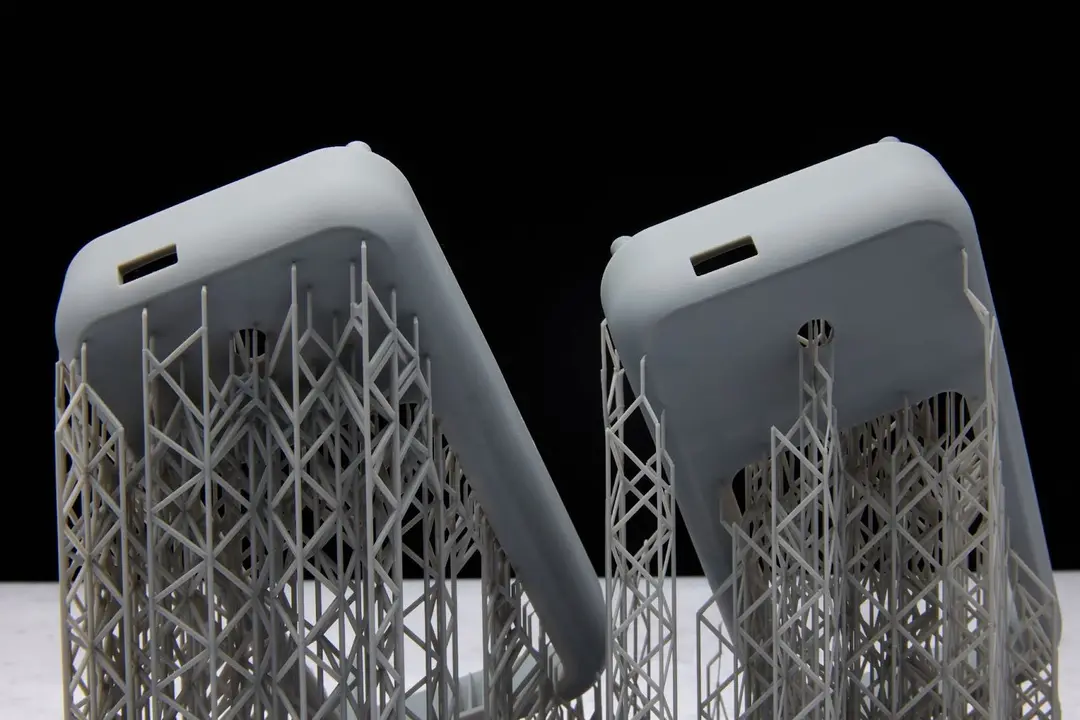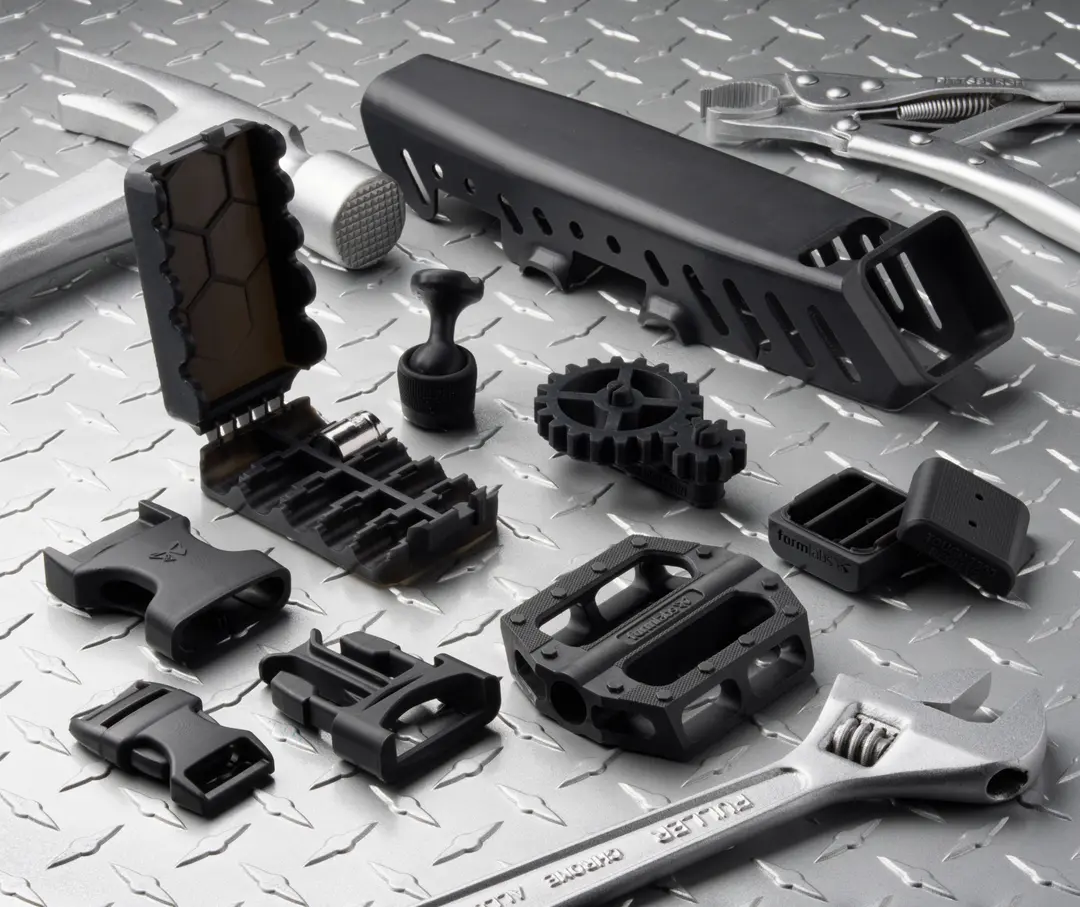Wenn Sie einen Stereolithografie-3D-Drucker (SLA) verwenden, müssen Sie verstehen, wie Ihre 3D-Druckteile aus Kunstharz nachzuhärten sind. Durch das Nachhärten erreichen Druckteile ihre höchstmögliche Festigkeit und werden stabiler. Die verschiedenen Kunstharze verhalten sich beim Nachhärten jedoch leicht unterschiedlich und benötigen verschiedene Nachhärtezeiten und -temperaturen, um die optimalen Materialeigenschaften auszubilden.
Laden Sie unseren Leitfaden über das Nachhärten von Kunstharzdruckteilen herunter, um zu erfahren, wie das Nachhärten funktioniert und wie es sich auf die verschiedenen Formlabs-Kunstharze auswirkt.
Warum sollte man Drucke aus Kunstharz nachhärten?
Each Formlabs Resin is formulated with advanced, light-sensitive polymer chemistries. Formlabs stereolithography (SLA) 3D printers use 405 nm lasers to cure the liquid resin, producing a highly accurate solid part. When an SLA part finishes printing, it remains on the build platform in a “green state.” This means that while parts have reached their final form, polymerization is not yet fully completed and the part has yet to attain maximum mechanical properties. Post-curing with light and heat is key to unlocking this last mile of material properties for SLA 3D prints. For biocompatible materials, post- curing is necessary to achieve the safety standards determined by regulatory agencies.
Achieving optimal properties is especially essential when using functional or specialty resins. Form Cure and Form Cure L, the two post-curing solutions from Formlabs, are designed to post-cure parts printed in Formlabs Resins with speed and consistency. Our engineers developed Form Cure and Form Cure L specifically to work with Formlabs Resins, using the same 405 nm light as the lasers in Formlabs SLA 3D printers. Parts are heated and automatically rotated in the reflective chamber to ensure an even and consistent post-cure.
Introduction to Post-Curing Science
Any resin used in SLA 3D printing can be thought of as a highly cross-linked macromolecule, or a continuous network of polymer chains (monomers and oligomers). Within that macromolecule, there are still some reactive groups that can further cross-link the polymer network when exposed to light and heat.
As more cross-links form, material properties, such as modulus and tensile strength, improve. The objective of post-curing is to link as many of these unreacted groups as possible to bring a part to its maximum material properties.
Once optimal material properties are reached, further post-curing of certain resins can sometimes cause brittleness or warping. The post-curing protocol must therefore be specific for both time and temperature in order to avoid curing too much, and will be unique to each resin and part geometry.
Optimal post-curing starts with heat. Rising temperatures increase the energy, and therefore mobility, in the polymer network. This gives reactive groups a higher probability of finding each other and creating more connections. Formlabs post-curing machines, the Form Cure and the Form Cure L, both use a heater to help the curing chamber quickly reach the desired temperature and then maintain it throughout the postcure.
Once the desired temperature is reached, light is introduced. Photons of light activate remaining photoinitiators, causing nearby reactive groups to form bonds and finish the cross-linking process. With each new cross-link the polymer network becomes more securely linked together and material properties improve.
As more cross-links form in the resin, the network slightly densifies, resulting in some minor shrinkage of the whole part. This is normal for any parts produced with a resin 3D printer. PreForm, Formlabs’ free print file preparation software, automatically compensates for this shrinkage to ensure your post-cured prints are dimensionally accurate to your original CAD designs.
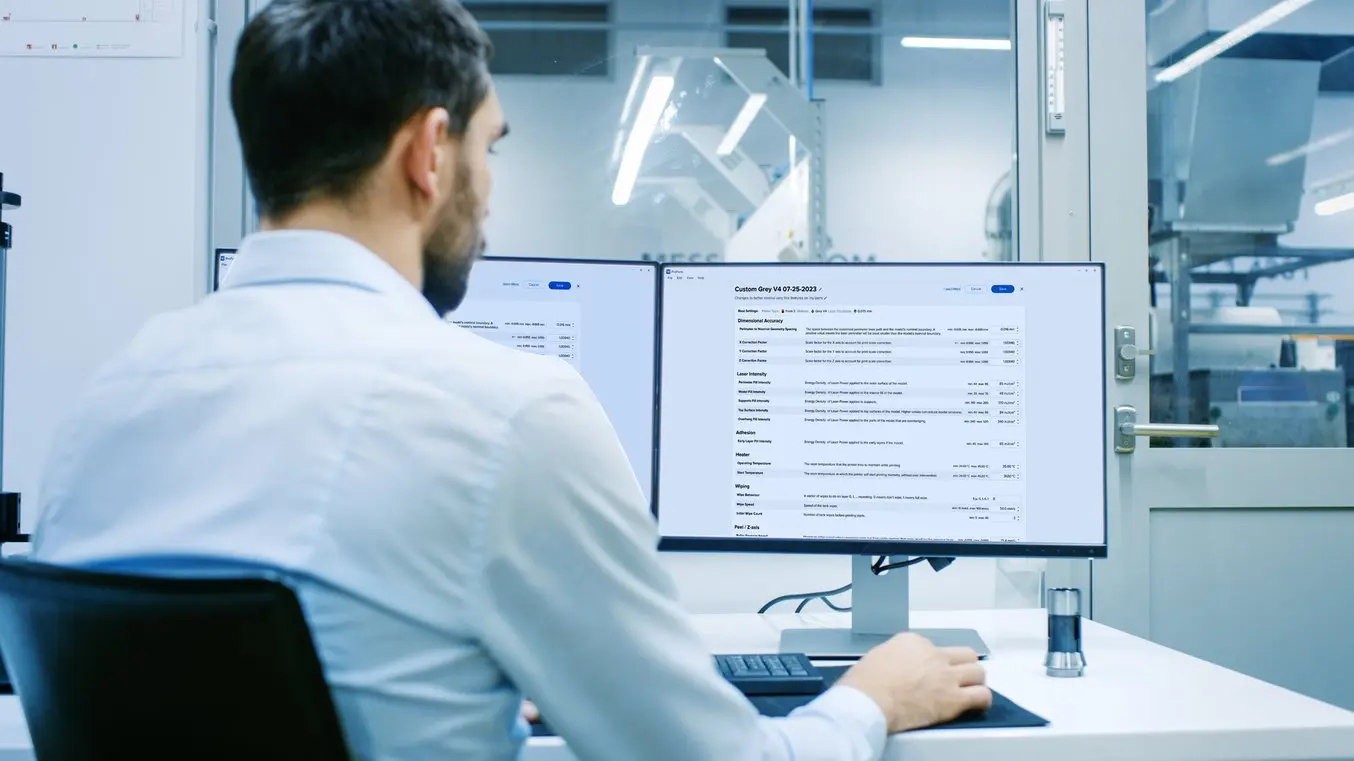
Kontaktieren Sie unser Vertriebsteam
Ganz gleich, ob Sie schnelle Prototypen herstellen oder fertige Teile für die Endverwendung produzieren, wir stehen Ihnen mit Rat und Tat zur Seite. Das Formlabs-Vertriebsteam besteht aus engagierten Fachleuten, die Sie und Ihr Unternehmen bei Bedarf mit professioneller Hilfe unterstützen.
Wie lange sollte man 3D-Drucke aus Kunstharz nachhärten?
Ideale Nachhärteeinstellungen sorgen dafür, dass die erforderlichen Eigenschaften bei kleinstmöglichem Zeitaufwand ausgebildet werden. Bei Formlabs' Standard-Kunstharzen kann dies eine schnelle, einminütige Nachhärtung im Form Cure V2 bedeuten. Wenn Festigkeit, Steifigkeit und Temperaturbeständigkeit eine Rolle spielen, lassen sich mit Formlabs' technischen Kunstharzen bei einer Nachhärtung von bis zu 120 Minuten (je nach der verwendeten Nachhärteeinheit) verbesserte Eigenschaften erreichen.
Formlabs hat betriebsintern eine Studie zu den optimalen Nachhärteeinstellungen für jedes einzelne Formlabs-Kunstharz durchgeführt. Mit der ASTM-Methode haben unsere Materialwissenschaftler*innen für jedes Material eine Reihe mechanischer Eigenschaften bei verschiedenen Temperaturen getestet.
Alle aktuellen Empfehlungen der Nachhärteeinstellungen für den Form Cure V2, Form Cure V1, Form Cure L V2 und den Form Cure L V1 finden Sie auf unserer Website. Materialdatenblätter mit den spezifischen mechanischen Eigenschaften nach Abschluss der empfohlenen Nachhärtung können ebenfalls von unserer Website heruntergeladen werden.

Dank des Form Cure L druckt Radio Flyer in kürzerer Zeit präzise Prototypen, darunter auch Teile für einen Roller.
Biocompatible Materials and Post-Curing
As more dental and medical professionals adopt 3D printing in their workflows, 3D printing companies have to ensure that the entire process is controlled to consistently manufacture high performing parts with biocompatible safety for the end user. Biocompatibility requirements require careful adherence to these pre-approved processes, and this applies to the post-cure step of the printing process as well.
Formlabs technology has been validated in FDA-cleared workflows, which means that for each resin intended for use in a biocompatible application, there are certain printing, washing, and curing steps that must be followed without deviation in order for the final part to be considered a biocompatible device.
The Form Cure and Form Cure L are important parts of these workflows. After careful testing and a thorough regulatory process, the validated settings for post-cure times ensure that each printed part for biocompatible applications has optimal mechanical properties and is consistently safe for use.
Find specific post-curing recommendations for each material in the Manufacturing Guide for each material.
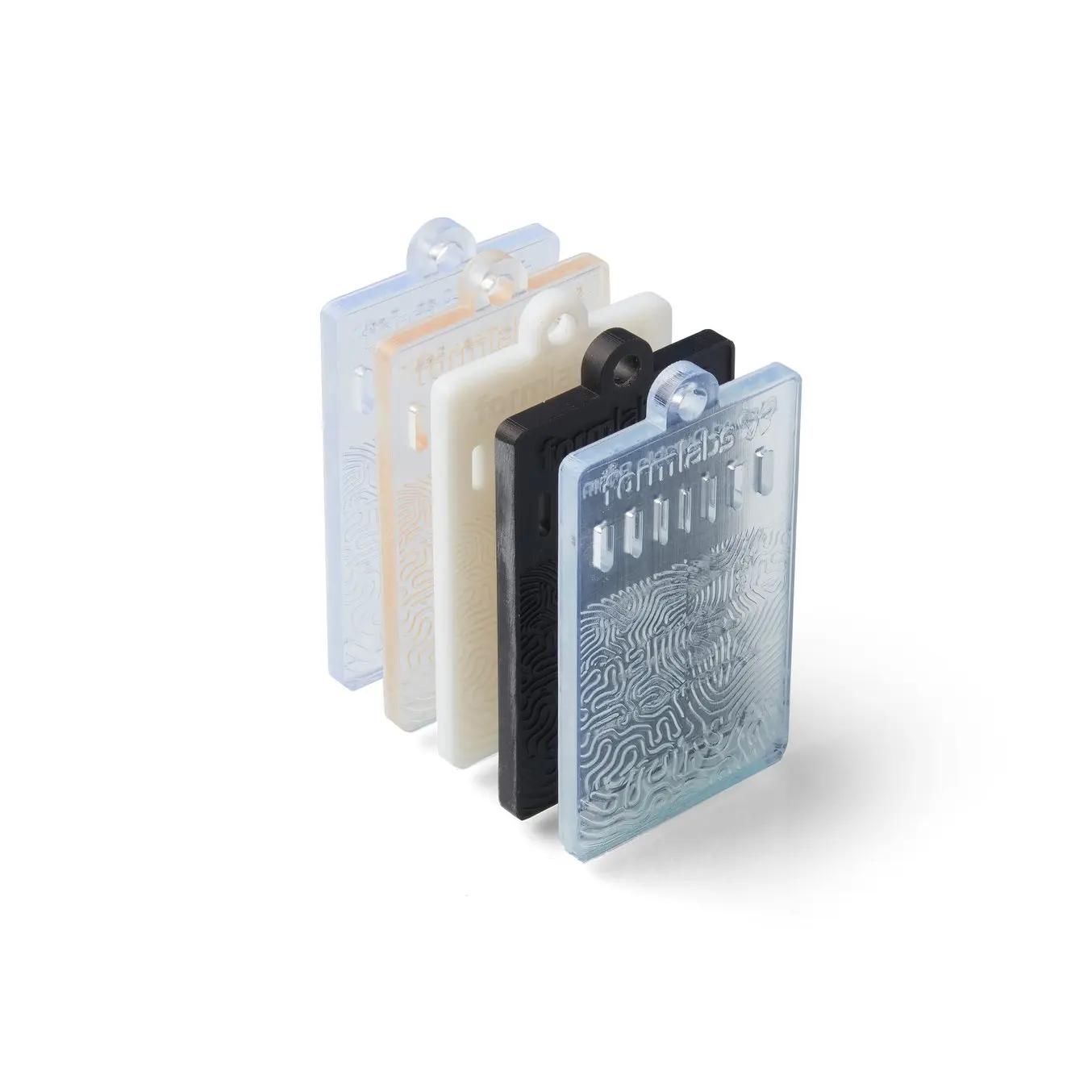
Proben der BioMed-Kunstharze
Jedes Probestück umfasst geprägte und hervorgehobene Merkmale, Ausschnittstärken von 0,5–2 mm sowie behördliche Regulierungen des jeweiligen Kunstharzes.
Methodology
An ideal post-cure setting achieves the properties you need in optimal time. Formlabs developed an in-house post-cure study to identify optimized settings for each individual Formlabs Resin. Using the ASTM method, our materials scientists tested a variety of mechanical properties at various temperatures for each material.
To see how post-curing influences mechanical properties, this guide looks at changes in the tensile modulus, which shows a change in stiffness of a part, for each resin over time in Form Cure or Form Cure L. An object with a higher tensile modulus will have a greater resistance to changing shape under stress. Modulus of elasticity is closely related to how completely crosslinked photopolymer chains are within the part, which is why Formlabs uses modulus to represent overall completeness of post-curing.
The “green” shape of a model is formed by laser-curing the resin during printing, but some potential polymer connections remain unbonded. Cross-linking the remaining polymer proportionally improves strength, stiffness, and temperature resistance. Post-curing also causes some part shrinkage. Formlabs measures accuracy and mechanical properties based on a standard post-cure of parts, and material settings are tuned to account for shrinkage under the same conditions.
The following graphs will help you understand how Formlabs materials respond to post-curing, viewed as a percentage increase in tensile modulus. Familiarity with post-curing behavior saves time and improves accuracy when post-curing parts for your particular application.

In this example, Rigid 4000 Resin exhibits a sharp rise in modulus of elasticity over the first 15 minutes of post-curing, increasing by 116%. After 15 minutes, no further improvements are observed.
Rigid 4000 Resin is a glass-filled composite material designed for parts requiring high stiffness and strength, as well as low deformation under load. Post-cure directly increases strength and stiffness by further crosslinking the polymer matrix surrounding microparticles of glass, holding them rigidly in place. Post-cure of Rigid 4000 Resin is substantially impacted by temperature. At higher temperatures, a large improvement in modulus of elasticity is gained over a short period of time. Post-curing beyond 15 minutes will not affect properties but will begin to cause cosmetic yellowing, and is not recommended. For most applications of Rigid 4000 Resin, post-cure for 15 minutes at 80 °C in Form Cure.
Post-Cure Troubleshooting
The most common issues encountered when post-curing parts are under-curing and warping. If parts seem weaker or less rigid than expected, they may be insufficiently post-cured. Undercuring can occur when a part is particularly thick or large, as larger parts take longer to heat. Light alone cannot post-cure much beyond the surface of a part, which is why Form Cure and Form Cure L apply both heat and light. If a part is significantly larger or thicker than Formlabs’ test geometries, it may require a longer post-curing time or higher temperatures to reach a full internal post-cure.
Warping during post-cure may occur if a part is especially thin, and is not equally exposed to light on all sides. Form Cure and Form Cure L help prevent warp by rotating the part on a turntable during post-curing, and by exposing the part to light from all directions — including underneath the turntable.
Post-cured parts also tend to be more brittle than green parts. Typically, as modulus increases elongation will decrease; because of this, over-cured parts can be undesirably brittle.
Ausrüstung zum Nachhärten
Es gibt viele Methoden zum Nachhärten, vom einfachen Härten mit Licht (Sonnenlicht, UV-Nagellampen, UV-Härtestationen, selbstgebaute UV-Härtekästen usw.) hin zur Kombination von Licht und Hitze. Hitze beschleunigt den Prozess und ermöglicht eine noch vollständigere Ausbildung der Molekülverbindungen, was zu verbesserten Materialeigenschaften führt, die mit Licht allein nicht möglich wären.
Der Form Cure und der Form Cure L, die Nachhärtungslösungen von Formlabs für professionelle 3D-Drucker für Desktop und Großformat, wurden dafür entwickelt, Druckteile aus den Kunstharzen von Formlabs schnell und konsistent nachzuhärten. Mit dem Form Cure und dem Form Cure L härten Sie SLA-Druckteile mit der richtigen Wellenlänge, bei verschiedenen Temperaturen und zeitgenau nach.
Form Cure uses a 405 nm light source, which was determined through an extensive internal testing process to be the most effective at creating the best modulus and tensile strength in parts printed on Formlabs printers. In comparison, when the time and temperature were the same, but a 365 nm light source was used, the modulus reaches only 67% as that of the 405 nm samples. There is a significant difference in the post-cured properties at each wavelength, especially so at shorter post-cure times.

Though the Form Cure L has the size to post-cure large parts, it can also be used to efficiently post-cure many small parts for batch production. A dental lab may have five Form 4B 3D printers, but need only one Form Cure L to cure all their parts at once, saving time, space, and labor.
Legen Sie los mit dem Nachhärten von SLA-3D-Drucken aus Kunstharz
Verwenden Sie den Nachhärteleitfaden von Formlabs, um zu verstehen, wie das Nachhärten die Haupteigenschaften der einzelnen Formlabs-Kunstharze beeinflusst. Legen Sie anhand dessen den optimalen Nachhärteplan für Ihre Anwendung fest.
Laden Sie den Leitfaden herunter für folgende Informationen:
- Einfluss des Nachhärtens auf die Haupteigenschaften der einzelnen Formlabs-Kunstharze
- Optimale Nachhärteempfehlungen für materialspezifische Anwendungen
- Strategien zum Vermeiden häufiger Nachhärteprobleme
